Ridge course skiing. Technique of skating
Ridge course skiing is unlike themselves skis, history is not so long. As is known, the first cross-country skiing classic style took place in Norway in 1842.
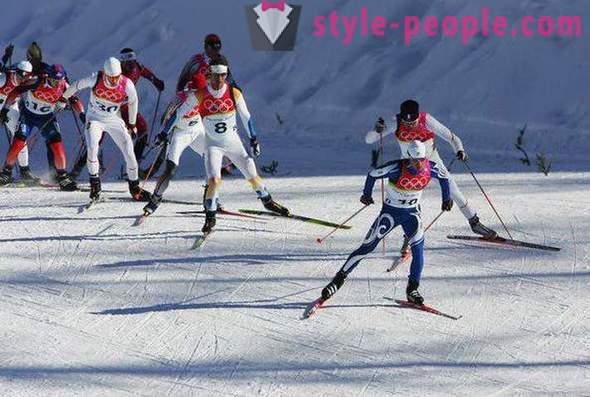
Regarding the skating stroke, note that it only appeared a century later, although local athletes have used this style of riding to overcome the high-speed corners and a strong recovery in the mountain. Cross-country skiing - that's what spurred skiers athletes not only search, but also to find more effective types of high-speed sliding. We used it partially and skiers athletes - for effective dispersal.
Up until the 80s of the last century skating style was in the shade: the main competition and training on skis sliding considered only the basic method - classic.
Pioneer skating style
It was the first to actively promote the progress of the ridge on skis Swede Gunde Svan. Legendary athlete thanks to him became a four-time champion at the Winter Olympics, seven-time champion and winner of the World Cup. He entered the racing history as the youngest Olympic champion, becoming them in twenty-two years. Gunde Svan has become a national hero since founded a new ridge fashion in skiing. Applying exclusively ridged course skiing, Swedish master rushed on race tracks with previously unknown speed, "armed" with a long pole (he then replaced by modified ski poles) that repels like rowing a canoe.
He was the first skiers athletes began purposefully "in speed skating" train. The new style is applied to the rolled, ie. E. Having no classical section the track, thanks to Swann Gunda was soon popularized and do cross-country skiing forever lost a strict peg to the "profile line". Athletes-skiers have become more intense in training to work on his speed endurance, practicing skating course skiing.
The objective factors of development of skating
We ask the question: "Could the ridged way of sliding on skis become the main competition in the middle of the last century?" I guess the answer is no. Athletes objectively could not adequately prove it on wooden skis, do not provide any desired level of slip, no proper stiffness repulsion, including due to the imperfect stiffness of fasteners. Athletes have also summed up the old, made of leather, is not strong enough and tough sports shoes.
We agree with the obvious fact that modern technology was brought back to life many topical nowadays sports and styles.
Technologically sports equipment XXI century. In particular, the plastic bottom of the ski - extremely slippery, which determines a significant increase in the speed of the skier. Modern "cool" racing skis have a sliding coating made of special amorphous polyethylene having a large molecular weight, as modified by the carbon fluoride, and graphite inclusions.
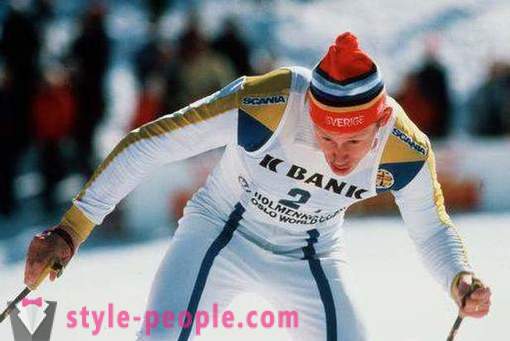
increase their resilience allowed to repay the vibrations caused during the race. To facilitate the weight of many firms in the racing models as a ski box filler used "cell" or synthetic foam filler
Recorded that on a flat road experienced athlete rushes (another word out of place here) at speeds up to 50 km / h, and a cross - at a speed of 35 km / h. It is surprisingly equivalent to rider velocity (canter - up to 50 km / h; trot - up to 35 km / h). Also note that the horse on snowed that speed, alas, not demonstrate.
Another important factor increasing the elasticity of the sock and heel ski sports that fundamentally improve their properties to overcome the outrun.
Embodiments of skating
Skating style immediately after his presentation, the renowned champion, the Swede has won worldwide recognition. In the eighties of the last century, it is completely replaced in the classic ski race and biathlon. Naturally, the skilled athletes and coaches have made their own experience in it, developed. Currently, the following types of ridge moves:
- odnoshazhny;
- dvuhshazhny;
- alternating dvuhshazhny;
- polukonkovy;
- ridge without ski poles.
Brief description of the ridge styles
Polukonkovy style is also called a hybrid. This ski during one ski moves on classical section door, and the other - on the highway without a profile, ie groomed... Athletes use it occasionally, when they want to temporarily reduce the load on the body.
Ridge course without ski poles, which are naturally more amateur, because it understandably less fast than the other four recognized sports experts. However, it is sometimes deliberately used in the training process even famous ski racers.
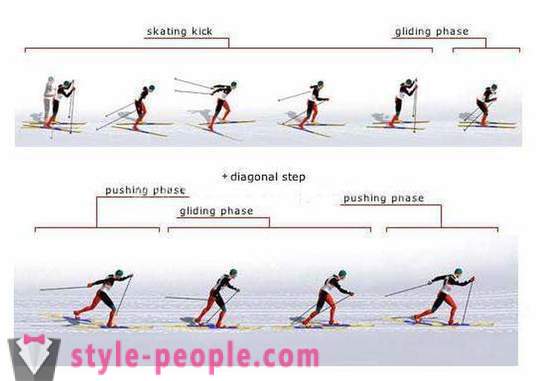
Ridge ski moves (COFO) have their own specific features. The athlete pushes the inner side of the ski, which serves a unique sliding stop. They COFO, higher demands, firstly, to shape the athletes, and secondly, their equipment.
In contrast to the classical style, athlete skier practicing COFO experiencing intense dynamic lateral loads on its propulsion system. During the race, there are active cyclic lateral oscillations of the body (referred to in this article, we will discuss its full cycle for one of the types of COFO).
The intensity of this load significantly increased transverse nature when going downhill skier. It depends directly on the ski breeding angle. If it is an even distance, depending on the speed of 15 to 45 degrees, the rise in the aforementioned angle increases to 75 degrees.
Naturally, the smaller the angle, the higher the speed of the skier. That's why experienced athletes (and this can be seen on TV, looking at reports from the cross-country skiing), he did a little.
Alternately dvuhshazhny course are mainly used in the most difficult areas of the ski slopes: on steep grades, with a sub-standard "soft" the track on tight turns. He - the slowest, but has its functional niche and they own all active athletes. Odnoshazhny skating course - the fastest version of COFO. His hone to perfection the great masters. This - their sprints in the decisive sectors. Seeing him in the race in the decisive sectors, where athletes ski speeding down the track with incredible speed - a real pleasure.
The most versatile, the most demanded - dvuhshazhny simultaneous skating move. They are the athletes most of the race track and his flawless technique plays a decisive role in their athletic achievements.
A preferred method for skating style
In this procedure, the course uses its skier is able to move around much faster, and both on the flat parts of the route, and up the hill. It is universal. Such an option course called "ridge simultaneous dvuhshazhny course." It consists of two differing in length, rate and duration of successive steps, culminating powerful repulsion simultaneously via both ski poles.
Methodically and optimal visual representation of this variant is the progress in the form of its six consecutive phases.
Description of the Related skating simultaneous dvuhshazhnogo stroke
The first phase, called single-point pure glide on the left ski, the athlete actively pushes the right foot. Range of motion it - from complete repulsion pending right foot forward and to the side. The left supporting leg which slides forward on the ski, the result is at the end of the slip ready for extension.
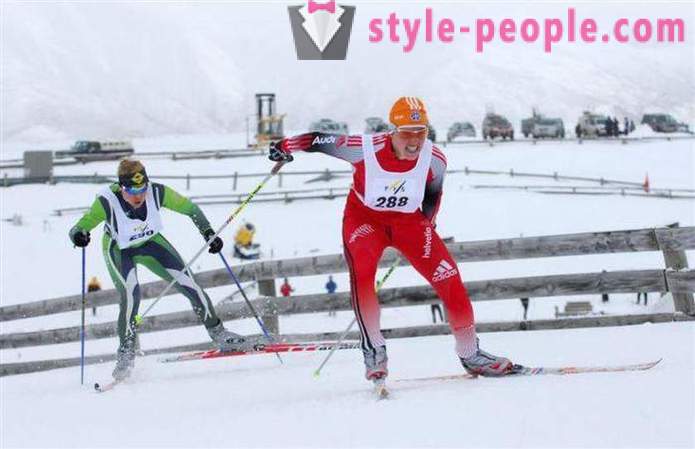
technique of skating tracks in this phase: the athlete's torso 50 degrees to the horizontal, the left leg at the knee bending angle - about 111 degrees in the hip joint - 91 degrees. Left ski must slide at an angle of 19 degrees to the direction of motion, during such sliding the left leg at the knee flexes to 31 degrees, and in the hip joint - 48 degrees. Produced trunk straightening 9 degrees. In the second phase of its ridged simultaneous dvuhshazhny course change as a left supporting leg, it becomes mixed. On the left ski athlete is not easy to slide, it also repelled by it. In turn, the right leg, first approached the left sharply - flapping - pushed forward and to the side. Thus "skier konkovik" sticks runs (unlike classical skier). All - because of the allocated towards the left supporting leg. Because of this, the left hand turns out to be rectified in the elbow and, accordingly, the first ski pole sticks, and at an angle more acute inside than the right. Sticks are widely spaced. Between their "legs" - a distance of about 1 m 3.
The third most active phase of the propulsion machinery is characterized by a ridge running from the point of view of efficiency. it sets the overall pace of athlete movements. Start phase - practically vertical staging the left stick, and the ending - left ski breaks away from the road. Skier vigorously carries forward lean of the trunk at an angle of 41 degrees, and straighten the left leg at the knee and the hip. Then, in a second step, the right ski is placed at an angle of 3-6 degrees to the main direction of movement. It helps support the right ski pole.
The fourth phase - a kind of litmus test, showing how to ride course ridge may athlete, effective or not. It is characterized by a preliminary "podsedaniem" to support the right foot and then a powerful push it. Followed by vigorous rejection at different times left and then right ski pole. Tremors foot and sticks must be very powerful.
If the athlete is not able to give them the necessary energy, it should carry out additional training: accentuated work in the gym, squatting with a barbell, ie loading the legs, as well as training the tempo movement on the triceps and deltoids... This phase is referred to have all our ski ridge moves (them - five), so our views on the optimal physical condition athlete valid for them. We continue the story of the fourth phase. Classic podsedaniya characteristics on the right leg as follows: legs bend angle of 106 degrees at the knee and the hip - 89 degrees. The trunk is tilted up to 36 degrees to reduce the load on the sliding ski and ski poles to facilitate propulsion.
The fifth phase is characterized by the repulsion of the right foot from following this in turn repulsions first left and then right ski pole. In this case, both the left and right hand - straight, actually extended in line.
In the sixth phase of the extension of the right ends (jogging) leg at the knee and ankle. Increases torso angle, the skier carries pure slip, already on two skis. Cyclic transition occurs in the first phase
How to master the skating stroke
Learning to move the ridge on skis can be a specialized sports section, under the guidance of a coach who owns them.
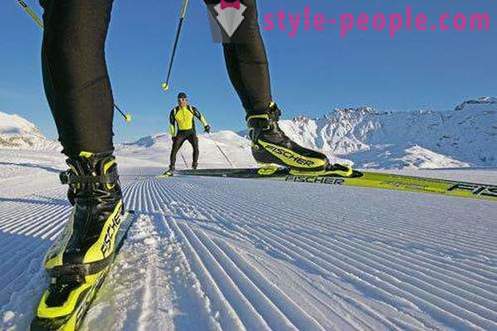
While reading the foregoing description of the ridge simultaneously dvuhshazhnogo turn, you will see for yourself how many details are important in applying the correct slip: the angle of the direction of the ski relative to the direction of motion, and torso angle, and leg strength push hands and with the help of ski poles, and overall coordination . In short, it alone can only learn the wrong course of the ridge.
For beginners the ski racing inventory
First, however, wishing to be purchased at a specialty store skis and boots for skating stroke. It is crucial to choose the right, adapted to the ridge sliding skis. They are matched in length: it should be 10-15 cm higher than the growth of the athlete. We ski a slightly rounded nose portion. Indispensable condition for their suitability is the increased rigidity. Therefore, the classic wooden skis are unsuitable for modern sports. Demanded the manufacturability of plastic models. Just when buying produce their first test on stiffness. You need to get up to them and imitate push. The criterion for fitness is to keep the gap between the floor and skiing. In addition, the side surface of the ski to be COFO edge, not disturbed. If you buy a ski b / y, then special attention should be paid to this point. In addition, we should pay attention to the existence of two technologies of their manufacture "sandwich" (simpler and cheaper) - for fans and "kap" - for professionals.
If you are an athlete, then, of course, is to choose among the products of high-tech skis specialized companies: Fischer, STC, Rossignol, Karhu, Madshus, Peltonen.
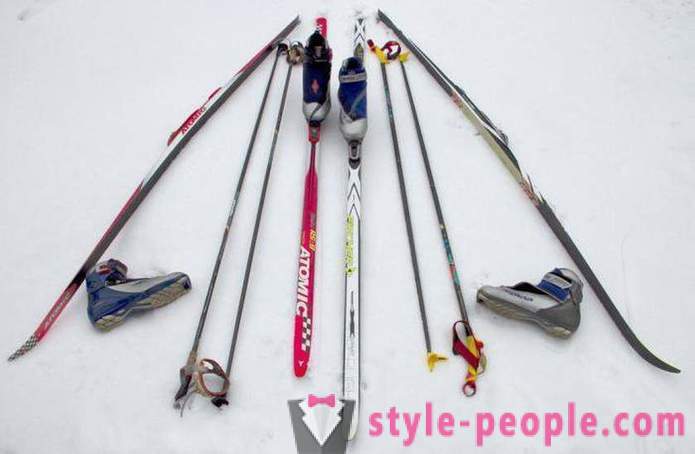
However, when buying expensive skis should be careful. Not only cross-country skis are expensive, but also mountain hiking. For example, good skiing "Fisher" for skating stroke, the mountain tour (which also loads can be significant), we would recommend Backcountry skiing.
There are two ski manufacturing technology. If you - a fan, you'll like technology "sandwich", which involves a wooden base, technologically pasted over plastic plates. For athletes participating in the competition, it is not fundamentally suited to solving competitions. Although it is possible the use of "sandwiches" in the training process.
Athletes are not worth saving, buying skis, manufactured at a cheaper technology. It is fraught with their early wear and breakage, as a professional daily stepped on his skis for 3-6 hours tough enough stress. high-end skiers, even in summer are in the Exercises. Roller skis for skating course to help them keep in shape during "off-season". Moreover, these devices now have become so technologically advanced that in the summer the skiers they are not only trained, but also compete. For the competition they are skaters SkiSkett Cobra, SkiWay FLASH.
Boots of skating are also produced specialized - on the basis of intense mechanical loads and high rigidity mounting requirements for COFO. They are sufficiently high and are provided with a special collar, the locking leg.
For athletes, the best fit products firms Salomon, Rossignol, Fischer, Botas, Alpina. Consider again, for example, shoes "Fischer". Their ultralight and heavy duty casing is made of two components Flex Comp 2 together with ideally favorable thrust heel HeelWedge, Velcro system Triple Fit and lacing Speed Lacing maximally facilitate adaptation to stress and sports shoes perfect fit. Bracing for the skating course - as high-tech and certified. Professionals most suitable fastening system SNS (the development of the French company Salomon) and NNN (Rottefella from the Norwegian company).
Individually chosen for a particular athlete sticks of skating. The athlete must choose their own. After all, with this taken into account, and growth, and the length of the arms, and the amplitude of the lateral movement on the track during movement.
On the modern elite cross-country skiing
Talking about ski racing, it would be tactless to get around in conversation active skiers, who create new achievements in this difficult and spectacular sport.
Today, of course, a trendsetter in ski racing is a 31-year-old Norwegian driver Petter Northug. This is - a great athlete: multiple Olympic champion, thirteen-time world champion. He came into the sport's elite by winning his first gold medal at the 2006 World Cup. Since then, his leadership is undisputed.
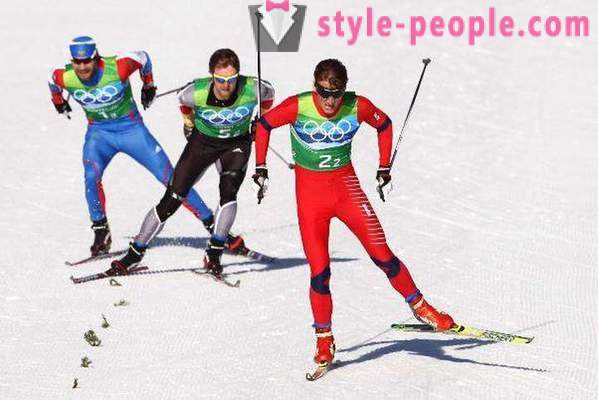
However, the current Olympic champion (Olympic Winter Games in Sochi) is a 33-year-old Russian Alexander G. easily. We think that a stimulus for the development of cross-country skiing in the next year or two will be competition between these two competitors.
Conclusion
Technique of skating on skis is specific and requires special abilities, skills, physical training and special equipment. Achieve high results in modern cross-country skiing and biathlon (where practiced skating stroke) novice is impossible without qualified guidance to an experienced coach. For an athlete is important speed endurance, overall coordination, power characteristics. Skilled skiers are in a special round Exercises using snowless season rollers.
In addition to sports personality traits, skiers also needed special equipment designed for adequate slip style ridge skiing mechanical load. Skis, boots, sports fixtures, sports sticks - all of this inventory is adjusted individually and commensurate to individual characteristics of the athlete.













































